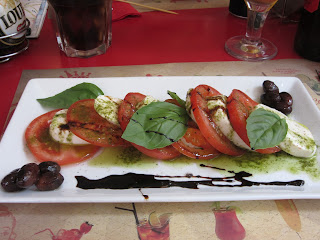Up around 9 this morning and we have a light breakfast, check mail and internet news. (Unfortunately, says Greg, the world didn't change overnight.) We first head to Mercat de Santa Caterina which is open and busy this morning. This is more of a local market, though there are a few of us snapping photos. There are egg shops, fruits, vegetables, olives, seafood, and meats. We buy a small bag of almonds to munch along the way.
 |
| Egg shop |
 |
| So many types of olives! |
This is the only place that we have to pay to use the restrooms.
We then head toward Plaza de l'Angel to meet our walking tour guide. At one point as we were puzzling over the map, an older Spanish man asked if we needed help. Beth pointed to where we wanted to go on our map. He spoke some Spanish, then motioned for us to follow him. He walked us around the corner and pointed. Very helpful!
This is another Sandeman's tour - we had a great experience with them in Madrid and Filipa, our guide here, knows Naomi, our guide in Madrid. Filipa is Bulgarian/American and speaks English well. There are three English speaking groups, about 20 in our group.
She begins with a synopsis of Spain's history from Romans to Germanic tribes to Moors to the French to an independent Catalonia when Wilfred the Hairy battles Charles the Bald (no kidding) of France. The Catalan language, still spoken in this area today, emerges as a mix of all of these languages. Spanish is also spoken by most, but many signs and things are in Catalan language. (It's all Greek to me!)
In 1469 Spain is united under Isabell and Ferdinand. Catalonia wants to be separate and independent but after several battles, it remains under Spanish rule. There is still desire for independence today and we see many flags which indicate this.
Catalonia makes two huge mistakes which stunt its growth a bit. First, Columbus goes first to Portugal for funding, then to Catalonia. Both laugh and turn him down, so he ends up going to Castille and Queen Isabella. The second mistake is when Gustav Eiffel comes to Barcelona and wants to build his tower here. He is turned down and of course goes to Paris instead.
Despite this, Barcelona thrives. We walk by the Cathedral and some 2nd century Roman ruins which were part of the gate into the walled city.
We go by the Picasso museum and learn that Picasso lived here for 10 years before going into exile in France. (He hated Franco and the feeling was mutual.)
We pause at St. Felip Neri Plaza which is where Gaudi often came to church. It was damaged during the Civil War when bombed by Mussolini, and Catalonians left the visible damage as a sort of memorial.
Both Hitler and Mussolini supported Franco.
We pass the remains of an underground synagogue - the oldest one standing in Spain.
There is a sport here in Catalonia which is building human towers.
This sculpture symbolizes the tower. Usually a small 5 year old child is the very top of the tower, since he weighs little. The only safety rule they have been able to enforce is that the 5-year old can wear a helmet!
We go by Santa Maria Del Mar church, built from blocks carried from the port. In 1910-20 the government attacked and destroyed much of the church. The Barcelona Football Club donated money to have it restored. During Franco's long reign, the Barcelona Football Club was a haven for rebels because Franco was a huge football fan and wouldn't bother them. "More than a Club" became their motto. There are Barcelona Football stores and many folks wearing their logo. World's Best player and highest paid athlete is their Lionel Messi.
There is some discussion of the Civil War and the rule of Francisco Franco, but once Franco died in 1975, his successor Juan Carlos reneged on his promises to Franco and moved the country towards democracy. There was a code of silence, which said that there would be no discussion of the recent past, no museums, no monuments - in order to move forward all must agree to start anew.
In 1992 the Olympics came to Barcelona and much of the infrastructure was rebuilt. The beach was built, pedestrian streets created. It is now the 4th most visited city in the world, according to some.
We say goodbye to the tour group, and decide to go back to the synagogue for a closer look. On the way we stop at Bernie's Diner and have one of the best hamburgers I've ever had. Greg has a great capresse salad and a local cervesa.
We talk with a man from Bristol, UK who is traveling on business. Favorite topics - English Premier League and American TV shows in UK. And, by the way, he kind of likes Donald Trump!
The synagogue was only discovered in 1996 and restored beginning 1975. It is only used for private ceremonies. The doorway is so low because Jewish synagogues could not be as tall or taller than any Catholic structure.
We continue on to Decathlon - a huge sporting goods store where we find shirts for Bryan and Matt. This store is several floors and has everything from mountain climbing gear to soccer to skating and just about any sport you can think of.
Many fashion stores and this fun Duck store.
We do some more people watching on the Ramblas, through Plaza Reial, then back to the room.
Note: There is a bullring in Barcelona but bullfighting has been outlawed in Catalonia and the bullring is now a mall! Also, the Policia are seen often here, but not as much as in Madrid. At least some of them tote machine-gun-type guns.




















No comments:
Post a Comment